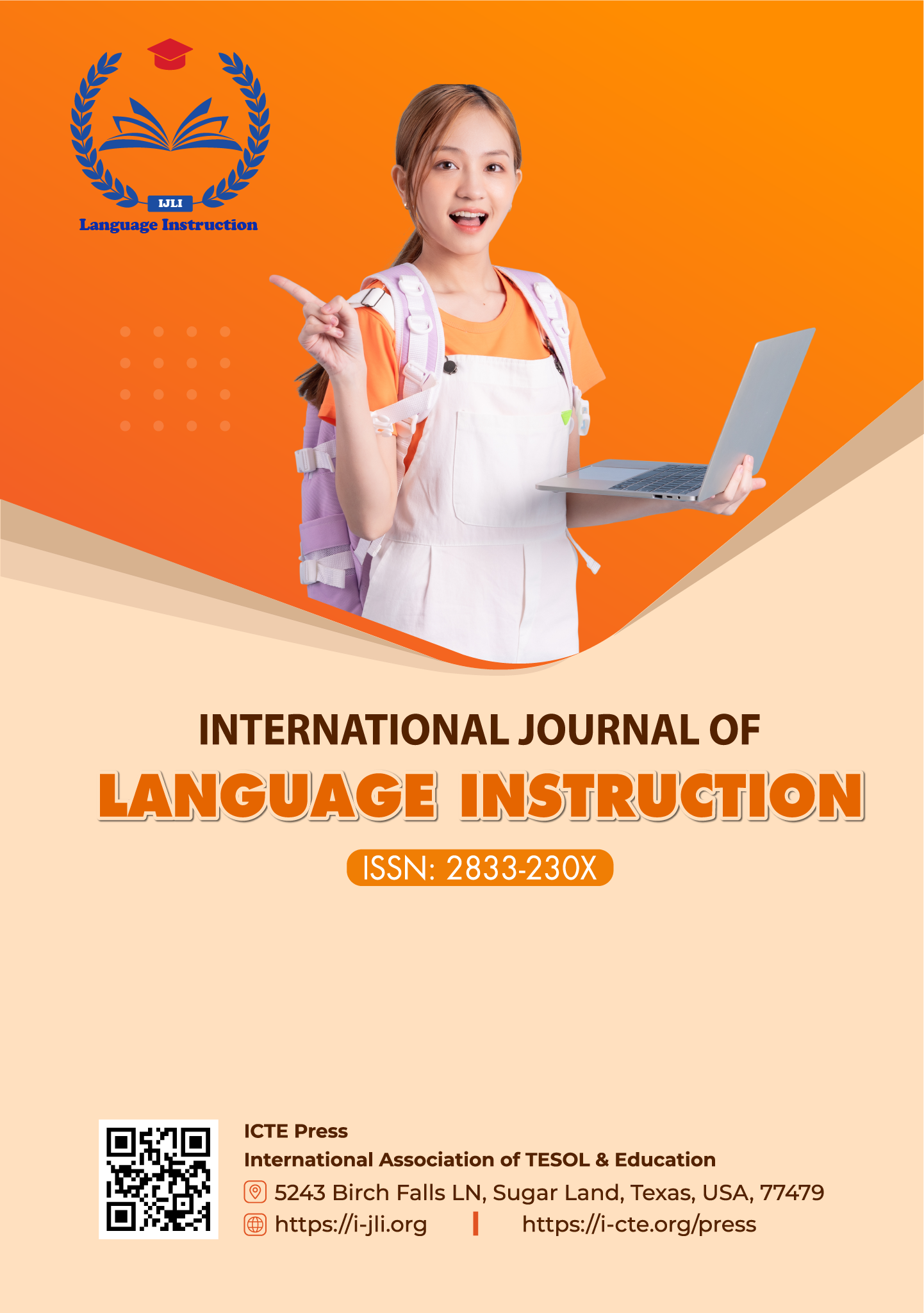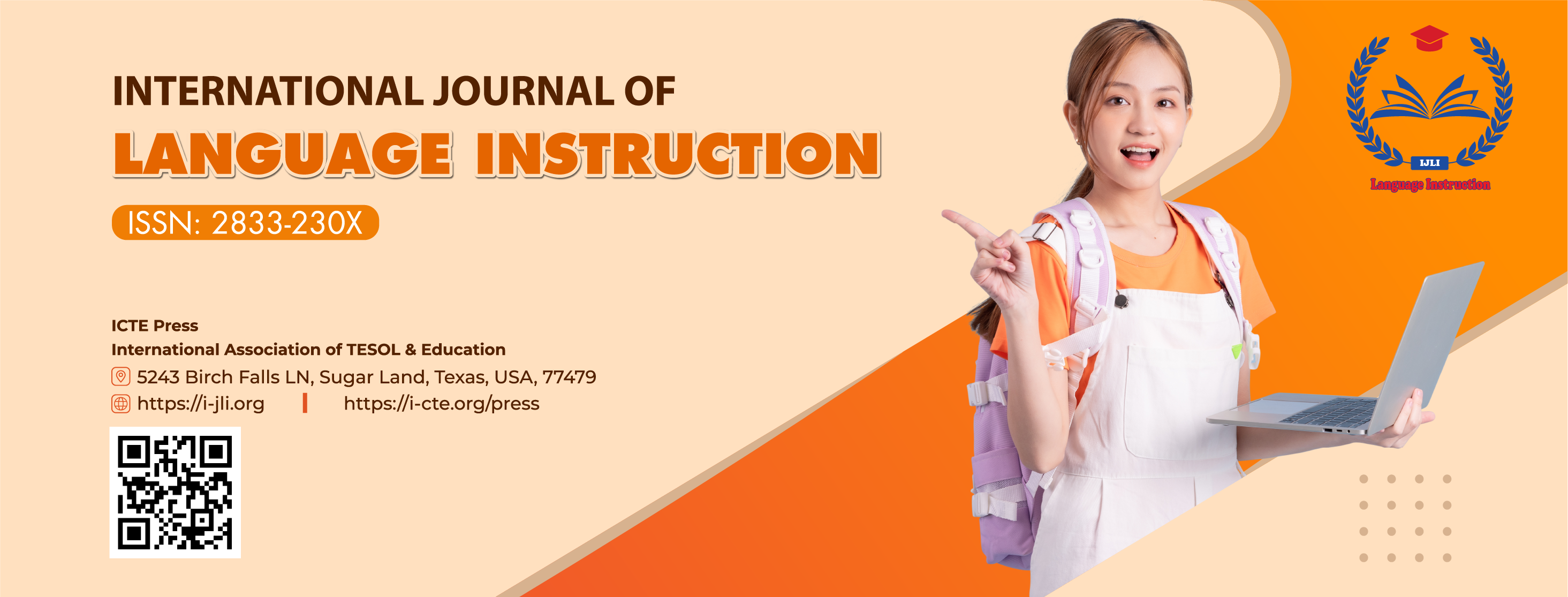Teachers’ Practices and Perceptions of Technology and ChatGPT in Foreign Language Teaching in Jamaica
DOI:
https://doi.org/10.54855/ijli.25421Keywords:
ChatGPT, Technology, Foreign Language Education, Social media, Web resources, JamaicaAbstract
Both the Covid-19 pandemic and the emergence of ChatGPT have influenced technology integration in teaching and learning. In Jamaica, few studies have examined the impact of ChatGPT on students’ learning and academic performance; however, no known research has specifically addressed its effects on foreign language (FL) teachers. The purpose of this study, therefore, is to explore evaluate teachers’ practices and perceptions of technology and ChatGPT in FL teaching in Jamaica. The current study collected data from 28 English, French and Spanish teachers who teach across the primary, secondary, and tertiary levels of the education system. A Google Forms questionnaire, which was circulated via FL teachers’ WhatsApp groups, was used to collect data over a two-month period through purposive and convenient sampling strategies. The study found that teachers utilize a variety of technological tools to enhance the teaching and learning experience. Findings also indicate that technology and ChatGPT present both benefits and challenges to the FL classroom. Furthermore, the study reveals that ChatGPT helps teachers to save time and energy; however, teachers must carefully scrutinize the information generated by the chatbot before passing it on to students. The study has implications for teacher training and professional development.
References
Ali, M. J., & Djalilian, A. (2023). Readership awareness series – paper 4: Chatbots and ChatGPT – ethical considerations in scientific publications. Seminars in Ophthalmology, 38(5), 403-404. https://doi.org/10.1080/08820538.2023.2193444
Al-Mahrooqi, R., & Troudi,S. (2014). Using Technology in Foreign Language Teaching. Cambridge Scholars Publishing. https://www.cambridgescholars.com/resources/pdfs/978-1-4438-6522-7-sample.pdf
Al-Smadi, M. (2023). ChatGPT and Beyond: The Generative AI Revolution in Education. arXiv preprint arXiv:2311.15198. https://doi.org/10.48550/arxiv.2311.15198
Alsaweed, W., & Aljebreen, S. (2024). Investigating the accuracy of ChatGPT as a writing error correction tool. International Journal of Computer-Assisted Language Learning and Teaching, 14(1), 1–18. https://doi.org/10.4018/ijcallt.364847
Arneil, S., Holmes, M., & Street, H. (2001). Review of Hot Potatoes. Language Learning & Technology, 5(2), 28-33. http://llt.msu.edu/vol5num2/review3/default.html
Blake, R. J., & Gullen, G. (2020). Brave new digital classroom: Technology and foreign language learning (3rd Ed.). Georgetown University Press. https://doi.org/10.2307/j.ctv1nc6rkf
Bang, Y., Cahyawijaya, S., Lee, N., Dai, W., Su, D., Wilie, B., Lovenia, H., Ji, Z., Yu, T., Chung, W., Do, Q.V., Xu, Y., & Fung, P. (2023). A multitask, multilingual, multimodal evaluation of ChatGPT on reasoning, hallucination, and interactivity. https://doi.org/10.48550/arXiv.2302.04023
Babl, F. E., & Babl, M. P. (2023). Generative artificial intelligence: Can ChatGPT write a quality abstract? Emergency Medicine Australasia, 35, 809–811. https://doi.org/10.1111/1742-6723.14233
Cabrera, L. (2018). Impact of Social Media in English Language Learning: Utilizing SWOT Analysis. In Basic Education Research Fund (BERF) (pp. 1–26). https://www.researchgate.net/publication/327822150_IMPACT_OF_SOCIAL_MEDIA_IN_ENGLISH_LANGUAGE_LEARNING_UTILIZING_SWOT_ANALYSIS
Campbell, J. L., Quincy, C., Osserman, J., & Pedersen, O. K. (2013). Coding in-depth semistructured interviews: Problems of unitization and intercoder reliability and agreement. Sociological Methods & Research, 42(3), 294–320. https://doi.org/10.1177/0049124113500475
Chapelle, C. A., & Sauro, S. (Eds.). (2017). The handbook of technology and second language teaching and learning. Wiley-Blackwell. https://doi.org/10.1002/9781118914069
Chaudry, I., & Kazim, A. (2021). Artificial Intelligence in Education (Aied) a High-Level Academic and Industry Note 2021. AI Ethics 2, 157–165. https://doi.org/10.1007/s43681-021-00074-z
Chinnery, G. M. (2006). Going to the MALL: Mobile Assisted Language Learning. Language Learning & Technology, 10(1), 9–16. http://dx.doi.org/10125/44040
Çobanoğulları, F. (2024). Learning and teaching with ChatGPT: Potentials and applicationsin foreign language education. The EuroCALL Review, 31(1), 4-15. https://doi.org/10.4995/eurocall.2024.19957
Dawadi, S., Shrestha, S., & Giri, R. A. (2021). Mixed-Methods Research: A Discussion on its Types, Challenges, and Criticisms. Journal of Practical Studies in Education, 2(2), 25-36. https://doi.org/10.46809/jpse.v2i2.20
Dedja, M. (2015). ICT in Foreign Language Teaching and Learning: Benefits and Challenges. European Journal of Language and Literature Studies, 2(1), 42-47. https://doi.org/10.26417/ejls.v2i1.p42-47
Elvan, D., & Mutlubaş, H. (2020). Eğitim-öğretim faaliyetlerinde teknolojinin kullanımı ve teknolojinin sağladığı yararlar [The use of technology in educational activities and the benefits of technology]. Mustafa Kemal Üniversitesi Eğitim Fakültesi Dergisi [Journal of Mustafa Kemal University Faculty of Education], 4(6), 100-109. https://dergipark.org.tr/tr/download/article-file/1271288
Elliott, M. T. J., P, D., & Maccarthaigh, M. (2024). Evolving generative AI: Entangling the accountability relationship. Digital Government: Research and Practice. https://doi.org/10.1145/3664823
Ferriera, M. R., & Ferriera, G. (2024). Online or Face-to-Face Modality: Students’ Preferred Instructional Modality for French and Spanish after the COVID-19 Pandemic in Jamaica. Journal of Arts, Science and Technology, 16(1), 125-147. https://www.utech.edu.jm/JAST/journal-of-arts-science-and-technology-volume-16-issue-1-1/view
Gong, Y., & Lai, C. (2018). Technology Integration into the Language Classroom: Developmental Trajectory of Beginning Teachers. Frontiers of Education in China, 13, 1–27. https://doi.org/10.1007/s11516-018-0001-5
Govindaraja, K., Goudar, R. H., Dhananjaya, G. M., Kaliwal, R. B., Rathod, V., Deshpande, S. L., Kulkarni, A., & Hukkeri, G. S. (2024). Enhancing Education with ChatGPT: Revolutionizing Personalized Learning and Teacher Support. EAI Endorsed Transactions on Internet of Things, 10. https://doi.org/10.4108/eetiot.6998
Guerra, A. (2023, July 6). The Future Benefits of Artificial Intelligence for Students. URBE University. https://urbeuniversity.edu/blog/the-future-benefits-of-artificial-intelligence-for-students
Haleem, A., Javaid, M., & Singh, R. P. (2022). An era of ChatGPT as a significant futuristic support tool: A study on features, abilities, and challenges. BenchCouncil Transactions on Benchmarks Standards and Evaluations, 2(4), 100089. https://doi.org/10.1016/j.tbench.2023.100089
Hanımoğlu, E. (2018). The Impact Technology Has Had on High School Education over the Years. World Journal of Education, 8(6), 96-106. https://doi.org/10.5430/wje.v8n6p96
Haye, K., Cunningham, D., Facey, D., Ellis, A., Ogeare, J., Morris, C., Morris, S., Miller, White, C., Hamilton, A., Cunningham, S., Jacobs, N., & Samuels, S. (2024). Beyond the Horizon: An investigation to unravel the impact of AI on Jamaican students’ performance. American Journal of Educational Research, 12(12), 479–502. https://doi.org/10.12691/education-12-12-2
Iqbal, N., Ahmed, H., & Azhar, K. A. (2022). Exploring teachers’ attitudes towards using chatgpt. Global Journal for Management and Administrative Sciences, 3(4), 97-111. https://doi.org/10.46568/gjmas.v3i4.163
Jamaica Gleaner (2023, June 9). Educator encourages teachers, students to embrace AI, p. A2. https://jamaica-gleaner.com/article/lead-stories/20230609/educator-encourages-teachers-students-embrace-ai
Kaliyadan, F., & Kulkarni, V. (2019). Types of Variables, Descriptive Statistics, and Sample Size. Indian dermatology online journal, 10(1), 82–86. https://doi.org/10.4103/idoj.IDOJ_468_18
Karataş, F., Abedi, F. Y., Gunyel, F. O., Karadeniz, D., & Kuzgun, Y. (2024). Incorporating AI in foreign language education: An investigation into ChatGPT’s effect on foreign language learners. Education and Information Technologies, 29(15), 19343–19366. https://doi.org/10.1007/s10639-024-12574-6
Kasneci, E., et al. (2023). ChatGPT for good? On opportunities and challenges of large language models for education. Learning and Individual Differences, 103, 102274.
https://doi.org/10.1016/j.lindif.2023.102274
Kessler, G. (2006). Assessing CALL teacher training: What are we doing and what could we do better? In P. Hubbard & M. Levy (Eds.), Teacher education in CALL (pp. 23–42). John Benjamins. https://doi.org/10.1075/lllt.14.05kes
Khan, M. Y., & Tufail, H. (2020). An Investigation into the Effectiveness of MALL during COVID-19 at the Higher Education in Pakistani EFL Classrooms. Global Language Review, V(I), 175-185. https://doi.org/10.31703/glr.2020(V-I).19
Khazhgaliyeva, G., Kassymova, A., & Medeshov, A. (2023). The role of internet resources in learning foreign languages at the faculty of electrical engineering. E3S Web Conf. XI International Scientific and Practical Conference Innovative Technologies in Environmental Science and Education (ITSE-2023), Vol 431, 1-14. https://doi.org/10.1051/e3sconf/202343102002
King, M. R. (2023). A conversation on artificial intelligence, chatbots, and plagiarism in higher education. Cellular and Molecular Bioengineering, 16(1), 1–2. https://doi.org/10.1007/s12195-022-00754-8
Kohler, K. (2024). You Only Need to Change Your Direction: A Look at the Potential Impact of ChatGPT on Education. Technology in Language Teaching & Learning, 6(1), 1–18.
https://doi.org/10.29140/tltl.v6n1.1103
Kohnke, L., Moorhouse, B.L., & Zou, D. (2023). ChatGPT for language teaching learning. RELC Journal, 54(2). https://doi:10.1177/00336882231162868
Kuure, L. (2011). Places for Learning: Technology-Mediated Language Learning Practices Beyond the Classroom. In: P. Benson and H. Reinders, Beyond the Language Classroom (pp. 35-46). Palgrave Macmillan. https://doi.org/10.1057/9780230306790_4
Lafford, B. A. (2009). Toward an ecological CALL: Update to Garrett (1991). The Modern Language Journal, 93(1), 673–696. https://doi.org/10.1111/j.1540-4781.2009.00966.x
Levy, M. (2015). The role of qualitative approaches to research in CALL contexts: Closing in on the learner’s experience. CALICO Journal, 32, 554–568. https://doi.org/10.1558/cj.v32i3.26620
Liu, Z.-Y., Spitsyna, N., Zubanova, S., & Vekilova, A. (2020). Retracted Article: Using Internet Resources for Remote Language Learning. International Journal of Emerging Technologies in Learning (iJET), 15(13), 22–33. https://doi.org/10.3991/ijet.v15i13.14653
Lozano, A. A., & Izquierdo, J. (2019). Technology in Second Language Education: Overcoming the Digital Divide. Emerging Trends in Education, 2(3), 52-70. DOI:10.19136/etie.a2n3.3250
Lutfi, M. (2015). The Unlikely Uses of Technology in a Second Language Classroom. Retrieved from https://laverne.edu/honors/wp-content/uploads/sites/39/2017/11/The-Unlikely-Uses-of-Technology-in-the-Second-Language-Classroom.pdf
Madden, O. N.,; Robinson, T. (2024). Exploring the interplay between WhatsApp and reflective journals in telecollaborative projects. In Y. Choubsaz, P. Díez-Arcón, A. Gimeno-Sanz, J. Hriňák, X. Liashuk, S. Pokrivčáková & H. Vančová (Eds.), CALL for Humanity - EUROCALL 2024 Short Papers. https://doi.org/10.4995/EuroCALL2024.2024.19100
Madden, O. N.; Williams, O.; Bernard, O. (2024). Exposing Francophone students to Jamaican language and culture: Reflections from the ClerKing telecollaborative project. In Y. Choubsaz, P. Díez-Arcón, A. Gimeno-Sanz, J. Hriňák, X. Liashuk, S. Pokrivčáková & H. Vančová (Eds.), CALL for Humanity - EUROCALL 2024 Short Papers. https://doi.org/10.4995/EuroCALL2024.2024.19099
Madden, O. N.; Grant, K.; Jackson, M.; Waite, D. (2024). ChatGPT and artificial intelligence in higher education in Jamaica: Opportunity or threat? Reviewing stakeholders’ perceptions. In Y. Choubsaz, P. Díez-Arcón, A. Gimeno-Sanz, J. Hriňák, X. Liashuk, S. Pokrivčáková & H. Vančová (Eds.), CALL for Humanity - EUROCALL 2024 Short Papers. https://doi.org/10.4995/EuroCALL2024.2024.19098
Madden, O., Sweeney, R., & Gonzales, A. (2023). Exploring the Use of Live Interactive Worksheets in Foreign Language Classes: Perceptions of Students and Teachers. International Journal of Language Instruction, 2(4), 1-18. https://doi.org/10.54855/ijli.23241
Madden, O. N. (2022). Edutainment: assessing students’ perceptions of Kahoot! as a review tool in French L2 classes. In B. Arnbjörnsdóttir, B. Bédi, L. Bradley, K. Friðriksdóttir, H. Garðarsdóttir, S. Thouësny,& M. J. Whelpton (Eds), Intelligent CALL, granular systems, and learner data: short papers from EUROCALL 2022 (pp. 240-245). Research-publishing.net. https://doi.org/10.14705/rpnet.2022.61.1465
Madden, O., & Foucher, A.-L. (2020). Connecting cultures and participation through WhatsApp: assessing students’ perception in the ClerKing telecollaborative project. In K.-M. Frederiksen, S. Larsen, L. Bradley & S. Thouësny (Eds), CALL for widening participation: short papers from EUROCALL 2020 (pp. 201-207). Research-publishing.net. https://doi.org/10.14705/rpnet.2020.48.1189
Mai, M. (2021). Advantages & Disadvantages of Social Networks in English Language Teaching. IOSR Journal of Research & Method in Education (IOSR-JRME), 11(3), 67-69. https://doi.org/10.9790/7388-1103076779
McMurry, B., Rich, P. J., Hartshorn, K. J., Anderson, N. J., & Williams, D. D. (2016). Criteria Language Teachers Use When Selecting CALL Technologies. The Journal of Language Teaching and Learning, 6(1), 49- 65. https://jltl.com.tr/index.php/jltl/article/view/19
Ministry of Education and Youth, Jamaica (2022). ICT IN EDUCATION POLICY. ICT: Transforming Lives, Empowering Citizens and Enabling National Development. Retrieved from https://moey.gov.jm/wp-content/uploads/2022/07/ICT-in-Education-Policy-Jamaica-Ministry-of-Education-and-Youth-2022.pdf
Naidu, K., & Sevnarayan, K. (2023). ChatGPT: An ever-increasing encroachment of artificial intelligence in online assessment in distance education. Online Journal of Communication and Media Technologies, 13(3), e202336. https://doi.org/10.30935/ojcmt/13291
Nguyen, T. T. H. (2023). EFL Teachers’ Perspectives toward the Use of ChatGPT in Writing Classes: A Case Study at Van Lang University. International Journal of Language Instruction, 2(3), 1–47. https://doi.org/10.54855/ijli.23231
Nuraeni, C. (2021). Maximising Mobile-Assisted Language Learning (MALL) amid Covid-19 Pandemic: Teachers’ Perception. Metathesis: Journal of English Language, Literature, and Teaching, 5(1), 11-18. http://dx.doi.org/10.31002/metathesis.v5i1.3336
Nyst, A. (2024, October 9). History of ChatGPT: A timeline of the meteoric rise of generative AI chatbots. Search Engine Journal. https://www.searchenginejournal.com/history-of-chatgpt-timeline/488370/
Pazilah, F., Hashim, H., &Yunus, M. (2019). Using Technology in ESL Classroom: Highlights and Challenges. Creative Education, 10, 3205-3212. https://doi.org/10.4236/ce.2019.1012244
Pham, V. P. H., & Le, A. Q. (2024). ChatGPT in Language Learning: Perspectives from Vietnamese Students in Vietnam and the USA. International Journal of Language Instruction, 3(2), 59–72. https://doi.org/10.54855/ijli.24325
Ranganathan, P., Caduff, C., & Frampton, CMA. (2024). Designing and validating a research questionnaire - Part 2. Perspectives in Clinical Research, 15(1), p. 42-45. https://doi.org/10.4103/picr.picr_318_23
Shankland, S. (2023, February 10). Why the ChatGPT AI Chatbot Is Blowing Everybody’s Mind. CNET. https://www.cnet.com/tech/computing/why-the-chatgpt-ai chatbot-is-blowing-everybodys-mind/
Sherma, A. B. (2024). ChatGPT’s Impact on Students’ Writing: Lessons Learned from Nepali Undergraduate Students. Journal of NELTA, 29(1), 83–96. https://doi.org/10.3126/nelta.v29i1.72636
Shorten, A., & Smith, J. (2017). Mixed methods research: Expanding the evidence base. Evidence-Based Nursing, 20(3), 74–5. http://dx.doi.org/10.1136/eb-2017-102699
Smits, J., & Borghuis, T. (2022). Generative AI and intellectual property rights. In: B. Custers & E. Fosch-Villaronga, (Eds.), Law and Artificial Intelligence. Information Technology and Law Series, 35, 323–344. T.M.C. Asser Press. https://doi.org/10.1007/978-94-6265-523-2_17
Stockwell, G. (2024). ChatGPT in language teaching and learning: Exploring the road we’re travelling. Technology in Language Teaching & Learning, 6(1), 2273. https://doi.org/10.29140/tltl.v6n1.2273
Strobl, C., Menke-Bazhutkina, I., Abel, N., & Michel, M. (2024). Adopting ChatGPT as a writing buddy in the advanced L2 writing class. Technology in Language Teaching & Learning, 6(1), 1–19. https://doi.org/10.29140/tltl.v6n1.1168
Thelma, C. C., Sain, Z. H., Mpolomoka, D. L., Akpan, W. M., & Davy, M. (2024). Curriculum Design for the Digital Age: Strategies for Effective Technology Integration in Higher Education. International Journal of Research, 11(7), 85‑201. https://doi.org/10.5281/zenodo.13123899
Thomas, M., & Schneider, C. (2020). Language teaching with video-based technology: Creativity and CALL teacher education. Routledge. https://doi.org/10.4324/9781003003311
Villalba S. M. (2017). Book Review: A practical guide to integrating technology into task-based language teaching, Marta González-Lloret. Language Value, 9(1), 218-221. http://dx.doi.org/10.6035/LanguageV.2017.9.9
Virgo, A. N. (2024). Leveraging Information Technology in Education: Insights from the Jamaican Context During the COVID-19 Pandemic. International Journal of Applied Science and Engineering, 12(1), 93-106. https://doi.org/10.30954/2322-0465.1.2024.8
Wang, C., Li, Z., & Bank, C. (2024). Understanding self-directed learning in AI-Assisted writing: A mixed methods study of postsecondary learners. Computers and Education: Artificial Intelligence, 6, 1-10. https://doi.org/10.1016/j.caeai.2024.100247
Wang, Y., & Stockwell, G. (2023). Social justice and technology in second language education. Iranian Journal of Language Teaching Research, 11(3), 1–18. https://doi.org/10.30466/ijltr.2023.121403
Warschauer, M., & Kern, R. (Eds.). (2000). Network-Based Language Teaching: Concepts and Practice. Cambridge: Cambridge University Press. https://doi.org/10.1017/CBO9781139524735
Ward, M.; Żammit, J.; O’Toole, J.; Madden, O. (2024). Designing, optimising and reflecting on CALL-informed technologies, pedagogies and practices: Case studies in Less Commonly Taught Languages (LCTL) and Endangered Languages (EL) contexts. In Y. Choubsaz, P. Díez-Arcón, A. Gimeno-Sanz, J. Hriňák, X. Liashuk, S. Pokrivčáková & H.Vančová(Eds.), CALL for Humanity -EUROCALL2024 Short Papers. https://doi.org/10.4995/EuroCALL2024.2024.19075
Widianingtyas, N., Mukti, T. W. P., & Silalahi, R. M. P. (2023). ChatGPT in Language Education: Perceptions of Teachers - A Beneficial Tool or Potential Threat? Voices of English Language Education Society, 7(2), 279–290. https://doi.org/10.29408/veles.v7i2.20326
Xu, X., Wang, X., Zhang, Y., & Ma, W. (2023). Can ChatGPT Facilitate the Implementation of Personal Learning Environments in Tertiary Education: Benefits and Risks. In M. Koc, O. T. Ozturk & M. L. Ciddi (Eds.), Proceedings of ICRES 2023-- International Conference on Research in Education and Science, (pp. 1113-1123), Cappadocia, Turkiye. ISTES Organization. https://files.eric.ed.gov/fulltext/ED654282.pdf
Yu, Bin. (2011). Computer-Mediated Communication Systems. tripleC: Communication, Capitalism & Critique. Open Access Journal for a Global Sustainable Information Society, 9(2). 531-534. https://doi.org/10.31269/vol9iss2pp531-534
Yue, S. (2024). The Evolution of Pedagogical Theory: from Traditional to Modern Approaches and Their Impact on Student Engagement and Success. Journal of Education and Educational Research, 7(3), 226-230. https://doi.org/10.54097/j4agx439
Zaiarna, I., Zhyhadlo, O., & Dunaievska, O. (2024). ChatGPT in foreign language teaching and assessment: exploring EFL instructors’ experience. Information Technologies and Learning Tools, 102(4), 176–191. https://doi.org/10.33407/itlt.v102i4.5716
Żammit, J. (2024). Capturing the full potential of Maltese language learning through ChatGPT. Technology in Language Teaching & Learning, 6(1), 1082. https://doi.org/10.29140/tltl.v6n1.1082
Zheng, C., Chen, X., Zhang, H., & Chai, C. S. (2024). Automated versus peer assessment: Effects on learners’ English public speaking. Language Learning & Technology, 28(2), 209–228. https://hdl.handle.net/10125/73578
Ziegler, N. (2016). Taking technology to task: Technology-mediated TBLT, performance, and production. Annual Review of Applied Linguistics, 36, 136–163. https://doi.org/10.1017/S0267190516000039
Downloads
Published
Issue
Section
License
Copyright (c) 2025 Oneil N Madden, Sheldon Gordon, Rovel Chambers, Jason-Lee Daley, Dave Foster, Malik Ewan

This work is licensed under a Creative Commons Attribution 4.0 International License.
The copyright of all articles published in the International Journal of Language Instruction (ijli) remains with the Authors, i.e. Authors retain full ownership of their article. Permitted third-party reuse of the open access articles is defined by the applicable Creative Commons (CC) end-user license which is accepted by the Authors upon submission of their paper. All articles in the ijli are published under the CC BY-NC 4.0 license, meaning that end users can freely share an article (i.e. copy and redistribute the material in any medium or format) and adapt it (i.e. remix, transform and build upon the material) on the condition that proper attribution is given (i.e. appropriate credit, a link to the applicable license and an indication if any changes were made; all in such a way that does not suggest that the licensor endorses the user or the use) and the material is only used for non-commercial purposes.
Authors are able to enter into separate, additional contractual arrangements for the non-exclusive distribution of the journal's published version of the work (e.g., post it to an institutional repository, in a journal or publish it in a book), with an acknowledgment of its initial publication in this journal.











